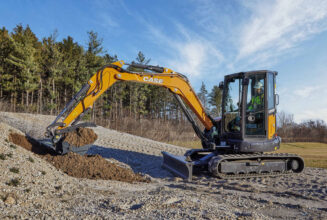Maintaining the Status Quo — or Not
By Elinor Bennett Markle
Everyone can admire a home like the one in this photograph. The house, situated on a very large lot, was built of tasteful materials and in pleasing proportions. It is set back from the street at a distance that matches the others in the neighborhood, and sits among a mix of existing trees with woods behind. There is plenty of well-treed lot space on each side so the adjacent houses do not crowd this one. When built, it was as a jewel held in a platinum setting. The abundance of trees, both mature and in sapling stage gave the house a wealth of natural interest, human scale, and asymmetrical balance and tied it to the land. Now, it is beheld within an unremarkable landscape that masks the building’s architecture.
The plants in this plan, other than the trees, are 100 percent evergreens and are well chosen for the heavy shade that exists there. However, the time has already come and gone for some judicious pruning and thinning. Vines clamber up several trees and even the face of the house. One wonders if anyone has considered the effect this has on the value of the home. Do they not realize that the house is disappearing behind the overgrowth? More likely, the homeowners have long grown accustomed to the well-traveled pathways into and out of the property and no longer notice how overly lush and dark the front yard has become. If I were the maintenance contractor here, I might take a few photographs like this one to show the homeowners just what other people see as they pass the lot.
A well-executed renovation of the landscape would complement the site and the neighborhood. However, it is a process not to be rushed. Making gradual yet substantial improvements in revitalizing the landscape of an older home requires enormous patience and understanding on the part of the maintenance contractor. Abrupt change can be upsetting for the humans, pets and the wildlife. So adjustment in or rearrangement of materials so we accomplish our goals should also maintain physical function and aesthetic balance, unity and rhythm in the design. The personal taste of the homeowner must first be recognized, and then respected before we make extensive changes in their property.
I would lobby to get those vines out of the trees and off the walls of the house. “Please, allow me to limb up the trees to a clear height of twenty feet to reveal the view to the front windows and door,” I would implore. I would beg to remove that boxwood that has grown so huge at the entry. And that little bench upon which no one has ever sat: “May I move it somewhere else into a space of its own; and, in its place, may I situate a lovely grey stone sculpture that would greet me as I walk to the front door?” I believe that would be more appealing than that lonely and empty bench. Yet, I love the stone flowerpots that flank it, and they could stay to flank that serene sculpture if I had my way.
The edge of liriope that lines the sidewalk seems a bit ”kinked” when viewed from this angle, and I might have to re-edge in a more graceful line, and do a bit of infill to smooth that curve, as it interrupts the flow. However, that kink does draw my attention to the recessed front door, so we could leave that decision until we settled the bench versus statue question. Honestly, if I could talk my way into it, I would like to see the entire line of liriope that graces the sidewalk leading to the front door moved toward the street several feet. That would give me room to install a mass of low growing shrubs to provide a higher sense of separation from the street.
If the owners were not interested in changing the existing liriope at the sidewalk, I would suggest another way to heighten their sense of privacy. I would create an island planting bed that encompasses the three trees to the left side of this photograph. The masses of trees and a ground plane of low-growing liriope of the same variety already in place would relate dynamically to the areas of “emptiness,” expressed by the void of this lawn — giving increased importance to the trees and the remaining lawn. I would further give continuity in the curvilinear shape of that bed by repeating the same radii of the existing planting beds. Those are easily mowed around, and graceful in appearance, further reinforcing that unity of form and material. I would reserve some large areas within that bed for daffodils, and those would show the spring fling of color for this front yard. As summer advanced, the scene would retreat into the cool green shades that it currently expresses.
Once gaining more sense of separation by either of these means, I would definitely remove the tree in front of the big window on the ground floor. That would be satisfying to me; surely the homeowner would like that as well. My pruning, transplanting additions and rearranging, if successfully and carefully implemented, would freshen the appearance of the property and solve the problem of the bare grassless areas under the large trees.
A maintenance makeover such as this could reveal and polish a scene so that it can be admired for another 30 years.
Elinor Bennett Markle, RLA, ASLA, is a landscape architect practicing in Kentucky and Tennessee. She can be reached via e-mail at lnrmarkle@yahoo.com.


